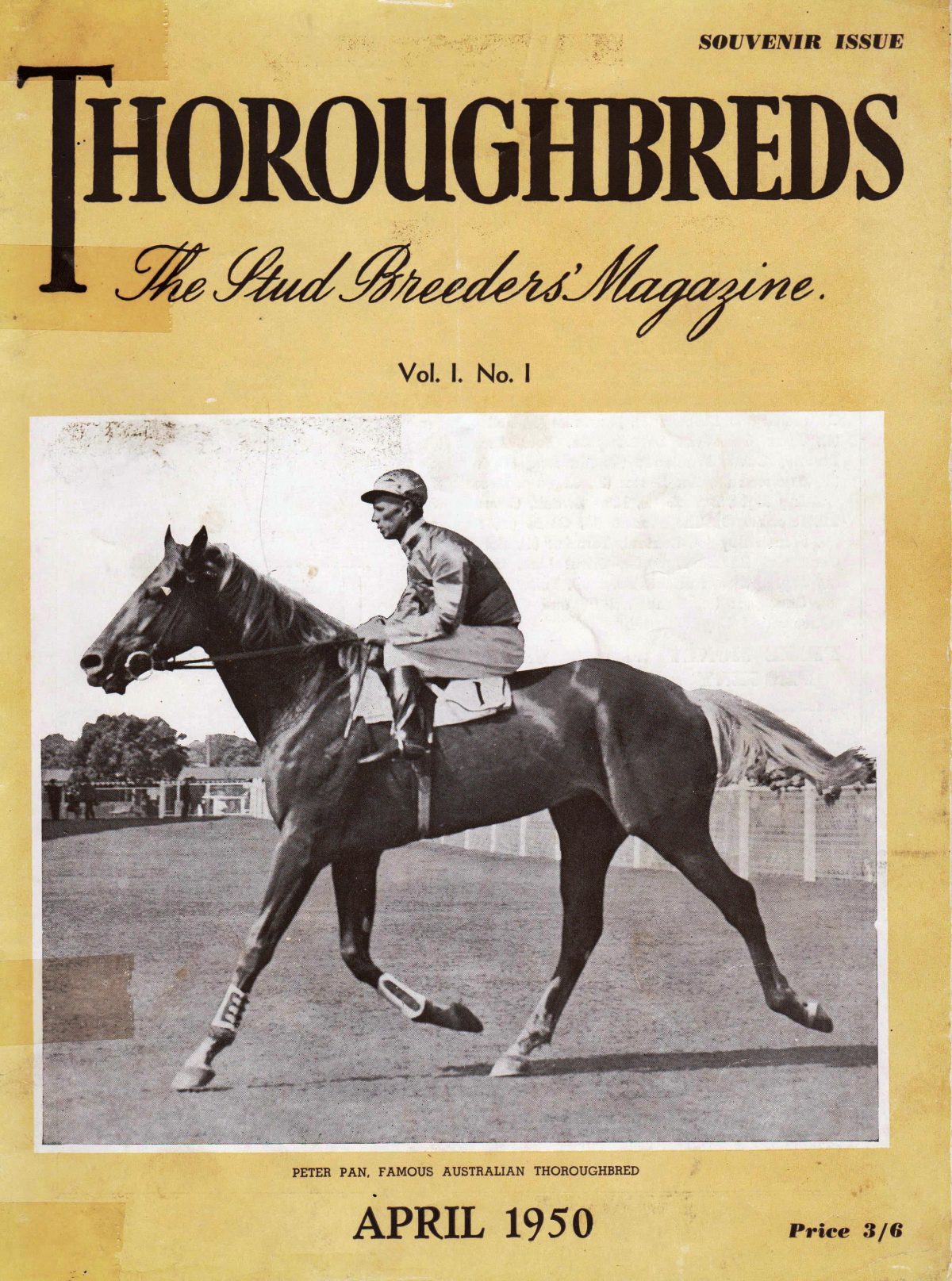Thoroughbreds Magazine 1950
There is little doubt (in my mind at least) that during the second half of the 20th century the late George Ryder was ‘lightning fast out of the blocks’ when it came to the promotion of thoroughbred racing and breeding in NSW. George had excellent ‘gate speed’ in modern racing argot. One of his early imports to Woodlands ‘Newtown Wonder’ also possessed this desirable trait; but could not maintain it for long?
George was the inaugural Managing Editor for the Australian Thoroughbreds Magazine. The featured image shows the front cover of Volume I Number I released as a souvenir issue in April 1950. George wrote the foreword which I have reproduced below. It’s just possible John Reeve, Production and Advertising Manager actually constructed the piece; but George signed off anyway!
Foreword
This is the first edition of “Thoroughbreds” which, as the name implies, is devoted to the thoroughbred racehorse.
For many years, Australia has been well to the fore in breeding horses that can be ranked with the best in the world. Perhaps the main contributing factor to this has been the great interest taken in this sphere by the breeders and the great affection they have for the horse., “the noblest of all animals”.
“Thoroughbreds” will have the interest of horse breeders and breeding at heart, and every article and story published in this magazine will first have been carefully considered for its value to the breeding industry in Australia.
From this you must not infer that the reading matter is going to be confined to dry, uninteresting statements of fact. Far from it. The best Australian racing and breeding writers have been assembled to form the staff of “Thoroughbreds”, and they have earned their reputations by writing interesting and enthralling material.
You will read about the great races of the champions of the turf as well as how they were bred: stud farms of Australia and overseas, as well as the great horses produced on these properties, and the men who make the bloodhorse breeding the respected industry that it is.
Throughout Australia there are grouped stud farms which compare more than favourably with those of any other country in the world, but I know that only a small percentage of horse lovers have visited these beautiful places. “Thoroughbreds” will bring them to you in stories and pictures, and let you see where the Peter Pans and the Bernboroughs that you have admired much on the race track, were born and raised.
In conclusion, I wish to thank all the organisations that have assisted in the production of this publication, and I particularly wish to express my gratitude to the members of the Bloodhorse Breeders’ Association of N.S.W., and to the publishers of “The Bloodhorse”, Lexington, Kentucky, U.S.A., for their invaluable help and encouragement.
Geo. E. Ryder
There’s a clue in the last sentence. George was feeding off the best in the USA. He followed this path many more times in the next four or five decades.
Content
The content in the inaugural “Thoroughbreds” makes fascinating reading. Even now almost 70 years later.
There are three articles of ‘veterinary’ interest. Murray Bain BSc MRCVS wrote on ‘Veterinary Science and Stud Routine’. Major E N ‘Norman’ Larkin submitted a ‘Review of Yearling Fillies’. This is interesting because Murray Bain was about to join up with Larkin and Frank Williams in Scone later in 1950. ‘The Brains Trust’ comprised William C Miller MRCVS FRSE; Mr E Brayley Reynolds OBE MRCVS; Dr J A Burkhardt MA MRCVS; Mr R C Crowhurst OBE MRCVS; Mr F T Day FRCVS; Mr Walter Griffiths and Miss A S Russell MRCVS. This was indeed the elite erudite hierarchy of the day in Newmarket, Suffolk, England.
Many of the most interesting advertisements were submitted by the thoroughbred stud farms; some advertising yearlings for sale at the upcoming Wm Inglis & Sons Easter Sale. Others promoted their stallions and amenities. “Aluinn Stud” at Muswellbrook stood ‘Genetout (Imp.)’ and ‘Columnist’ (by Genetout) both at 200 Guineas to ‘approved mares only’. “Kia Ora Stud” promoted ‘Midstream’ (Imp.) then hot property as the sire of champion ‘Shannon’. “Widden” presented photos of its yearlings by ‘Al Wassat’ and ‘Brueghel’. “Redbank” (‘Port Vista’, ‘Confessor’ and Valiant Chief’); “Segenhoe” (‘High Caste’ and ‘Al Dakhil’); “Sledmere” (‘Harinero’ and ‘Captain Gates’); “Puen Buen” (‘Al Nasser’ and ‘Actor’); “Alabama” (‘High Peak’ and ‘Double Remove’); Merton Stud (‘Macarthur’); “Woodlands” (‘Confessor’, ‘Al Dakhil’ and ‘Delville Wood’); “Baramul” (‘Kerry Piper’); “Kingsfield” (‘Cape Race’); “Yarraman Park” and “Carrington” (‘Stockade’, ‘Whirlaway’, ‘Al Dakhil’ and ‘Al Wassat’) all used “Thoroughbreds” to promote their products. Significantly almost all the stallions were imported with the exception of ‘Columnist’. Now almost 70 years on the names of the studs would be almost the same? Poignantly and presciently at least one is now a massive coal mine!
“Thoroughbreds” also featured in depth articles on ‘Racing and Breeding in England’, ‘Peter Pan’, ‘Pharos and Fairway’, ‘Speed and Heredity’, ‘High Caste’, ‘Eclipse’, ‘Illhuminata’s Influence on Australian Stock’ and ‘Progressive Policy of Breeders Associations’. George Ryder later developed his own interpretation of ‘Speed and Heredity’: “Put speed to speed and prey they stay”! He also said at one stage when attempting to buy a son of Dr Fager (USA): “In Australia we need horses that can fly around saucers”. He was referring to our ‘restricted’ racetracks and mainly sprint race programs; at least in NSW.
The luminaries of the industry in the Upper Hunter then were George Ryder (Woodlands) himself; A O Ellison (Baramul), A H Thompson (Widden), Laurie Morgan (Redbank), Maurie Point (Sledmere), Lionel Israel (Segenhoe), Syd White (Carrington), Percy Miller (Kia Ora), Messrs Basche (Merton) and Ray Bowcock (Alabama).
Like many similar products “Thoroughbreds” ran its course. There have been myriad reiterations in the interim: ‘Turf Monthly’ springs to mind. They seem to last about the same time as a single generation of horses”










